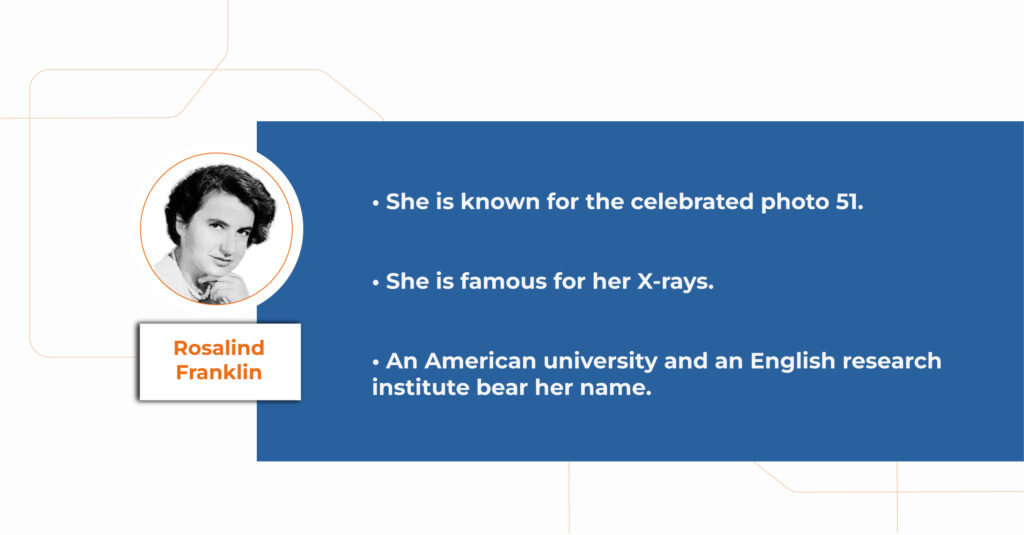Rosalind Franklin: Unveiling the DNA Helix and Beyond
- She is known for the celebrated photo 51
- She is famous for her X-rays
- An American university and an English research institute bear her name

Her name is Rosalind Franklin. Her crucially important X-ray crystallography work was key to the formulation of an accurate description of the double-helical structure of DNA
Born on July 25, 1920, in London, England, Franklin emerged as a pioneering figure in molecular biology and X-ray crystallography during the mid-20th century. One could hardly overstate her contributions to the discovery of the helical structure of DNA.
Franklin’s Early Life
Fascinated by the intricacies of nature, she pursued a degree in chemistry at Newnham College, Cambridge. While at Newnham, she distinguished herself as a sharp-minded scholar with an unwavering dedication to scientific inquiry.
Franklin’s contributions to the description of the DNA double-helical structure
Franklin’s groundbreaking scientific contributions centered on her pioneering work in X-ray diffraction techniques. “Photo 51” is an X-ray diffraction image taken by Franklin and her graduate student Raymond Gosling in 1952, providing crucial data on the helical structure of DNA. The image played a key role in James Watson and Francis Crick’s development of the DNA double helix model, published in 1953. Franklin’s contribution was not fully recognized at the time and despite recognizing her data, no mention of Franklin appeared in the original publication of Watson and Crick’s model. This omission has sparked debate and controversy in the scientific community for decades.
Her work paving the way for accelerated scientific breakthroughs
Understanding the precise structure of DNA represents a monumental paradigm shift, and the wealth of knowledge derived from it is virtually limitless. This encompasses a wide array of fields, including DNA replication, transcription, translation, DNA damage and mutation, DNA repair pathways, PCR, sequencing, CRISPR, and epigenetics.
Beyond the DNA structure
Franklin’s contributions extended beyond her work on DNA: she transitioned from researching DNA to studying the tobacco mosaic virus (TMV), swiftly leaving a significant impact on understanding the structure of TMV. Understanding the virus’s structure provided a foundation for early molecular biology, enabling the use of TMV as a model to aid in deciphering the genetic code. She also investigated the virus responsible for polio. Collaborating with Aaron Klug and John Finch, they published the poliovirus structure the year after her passing, dedicating the paper to her memory. Aaron Klug later received the 1982 Nobel Prize in Chemistry for his contributions to elucidating the structure of viruses.
Meticulous at Work Coupled with a Playful Spirit
Franklin’s exceptional intellect and unwavering commitment to truth and accuracy in her research were the driving forces behind her scientific endeavors. In the lab, she was known for her meticulous attention to detail and uncompromising standards.
Behind Franklin’s formidable intellect and scientific prowess, there existed a spirited and often humorous side to her personality. Despite the intense pressure of her research, she maintained a keen sense of humor and an irrepressible spirit.
One amusing anecdote recounts how Franklin, once accidentally set her hair on fire while conducting an experiment in the laboratory. Undeterred, she calmly extinguished the flames and resumed her work without missing a beat. This memorable incident was another testament to her unflappable nature and steely resolve.
Gone Too Soon
Franklin’s life was cut short far too soon when she succumbed to ovarian cancer at the age of 37. Her death happened just four years before the Nobel Prize in Physiology or Medicine was awarded to Watson, Crick, and Maurice Wilkins for their work on the structure of DNA.
While she may have been denied the recognition she deserved in her lifetime, Franklin’s legacy is a testament to the power of perseverance, intellect, and unwavering commitment to scientific discovery.
Recommended Sources for Digging Deeper
- Maddox, Brenda. Franklin: The Dark Lady of DNA. HarperCollins, 2002.
- Franklin was so much more than the ‘wronged heroine’ of DNA. Nature. 2020 Jul;583(7817):492. doi: 10.1038/d41586-020-02144-4. PMID: 32694848.
- Olby, Robert. Franklin and DNA. W.W. Norton and Company, 1974.
- Franklin, R. E., and Gosling, R. G. “Molecular Configuration in Sodium Thymonucleate.” Nature, 171(4356), 740-741. 1953.
- Judson, Horace Freeland. The Eighth Day of Creation: Makers of the Revolution in Biology. Cold Spring Harbor Laboratory Press, 1996.
- Sayre, Anne. “Franklin and the Double Helix.” Physics Today, 54(3), 66-73. 2001.
- Maddox, Brenda. “Franklin’s Legacy.” Nature, 219(6), 251-253. 2001.
- Wilkins, Maurice. The Third Man of the Double Helix: The Autobiography of Maurice Wilkins. Oxford University Press, 2003.
- https://www.science.org/content/article/Franklin-franklin-and-damage-gender-harassment

